Wildlife Photographer of the Year is an internationally renowned competition that recognises, rewards and celebrates the work of talented photographers, from amateurs to professionals. A couple of months ago, we had the contest's overall winners, and now the public is invited to have its say in the Natural History Museum's competition by voting for the winner of the People's Choice Award.
"Fans of wildlife photography around the world can choose their favourite from 25 images. The images were shortlisted by the Natural History Museum from over 49,000 image entries from across the world," the organization wrote in its press release. "This year's selection of images includes two endangered Iberian lynx kittens making an abandoned hayloft their playground, a family of beavers in their favourite feeding spot, a distinctive portrait of a Japanese warbonnet and a group of burrowing owls living in harmony with their human neighbours in Florida's Ten Thousand Barrier Islands."
Voting ends on 2 February 2021.
#1 "Lion King" By Wim Van Den Heever
As Wim watched this huge male lion lying on top of a large granite rock, a cold wind picked up and blew across the vast open plains of the Serengeti, Tanzania. A storm was approaching and, as the last rays of sun broke through the cloud, the lion lifted its head and glanced in Wim’s direction, giving him the perfect portrait of a perfect moment.
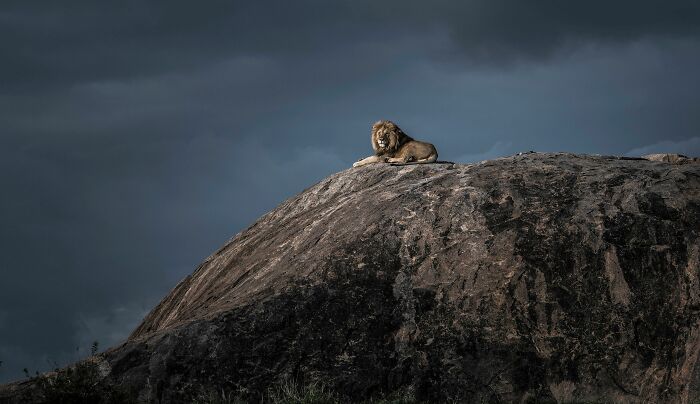
Image credits: nhm
#2 "Family Portrait" By Andrew Lee
Capturing a family portrait of mum, dad and their eight chicks proved tricky for Andrew – they never got together to pose as a perfect 10. Burrowing owls of Ontario, California often have large families so he knew it wouldn’t be easy. After many days of waiting, and when dad was out of sight, mum and her brood suddenly turned wide-eyed to glance in his direction – the first time he had seen them all together. He quickly seized the precious moment.
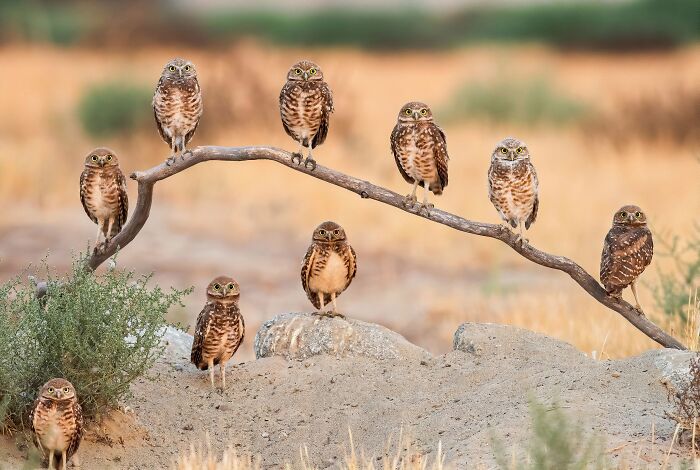
Image credits: nhm
#3 "Close Encounter" By Guillermo Esteves
The worried looking expression on this dog’s face speaks volumes and is a reminder that moose are large, unpredictable, wild animals. Guillermo was photographing moose on the side of the road at Antelope Flats in Grand Teton National Park, Wyoming, USA, when this large bull took an interest in the furry visitor – the driver of the car unable to move it before the moose made its approach. Luckily, the moose lost interest and went on its way after a few moments.
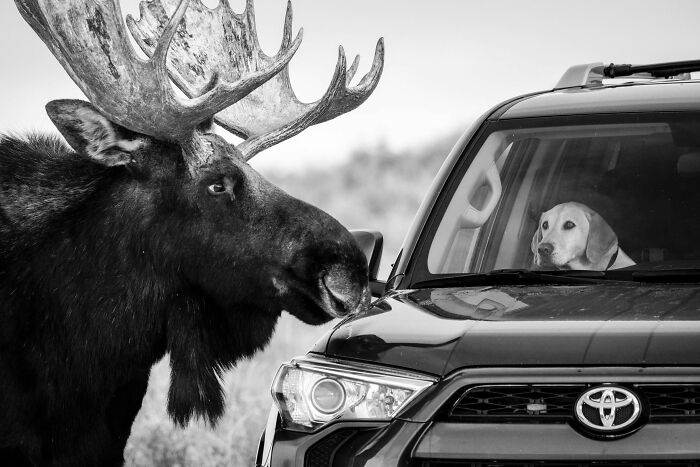
Image credits: nhm
#4 "The Last Goodbye" By Ami Vitale
Joseph Wachira comforts Sudan, the last male northern white rhino left on the planet, moments before he passed away at Ol Pejeta Wildlife Conservancy in northern Kenya. Suffering from age-related complications, he died surrounded by the people who had cared for him. With every extinction we suffer more than loss of ecosystem health. When we see ourselves as part of nature, we understand that saving nature is really about saving ourselves. Ami's hope is that Sudan’s legacy will serve as a catalyst to awaken humanity to this reality.
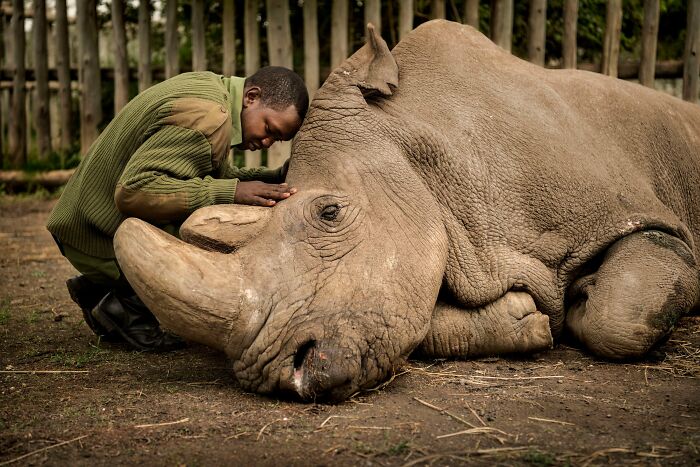
Image credits: nhm
#5 "Shut The Front Door" By Sam Sloss
This coconut octopus was spotted walking around the black sand of the Lembeh Strait, Sulawesi carrying its house made of shells. Remarkably, this small octopus constructs its own protective shelter using clam shells, coconuts, and even glass bottles! These intelligent creatures are very picky when it comes to choosing the perfect tools. They know that certain types and sizes of shell have their advantages, whether they be for shelter, camouflage, or concealing themselves from both prey and predator alike. It is safe to say that the coconut octopus is certainly one of the most scrappy, resourceful, and brainy creatures in the ocean.
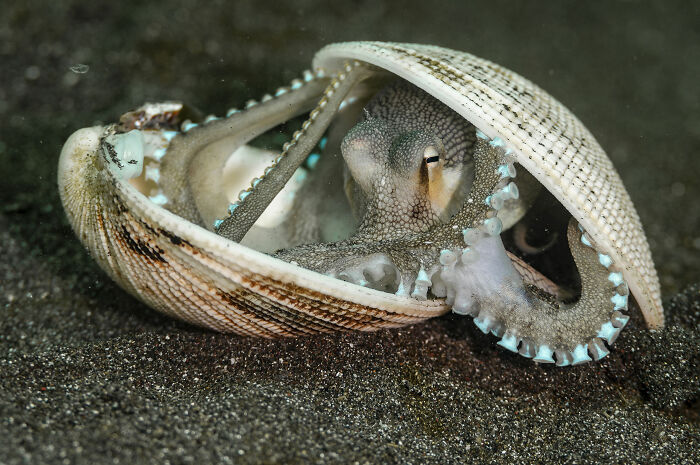
Image credits: nhm
#6 "Hare Ball" By Andy Parkinson
Andy spent five weeks watching the mountain hares near Tomatin in the Scottish Highlands, waiting patiently for any movement – a stretch, a yawn or a shake – which typically came every 30 to 45 minutes. As he watched, frozen and prostrate, with 50 to 60 mph winds surging relentlessly around him, the cold started to distract and his fingers clasping the icy metal camera body and lens began to burn. Then relief came as this little female moved her body into a perfect spherical shape. A movement of sheer joy. Andy craves such moments: the isolation, the physical challenge and, most importantly, time with nature.
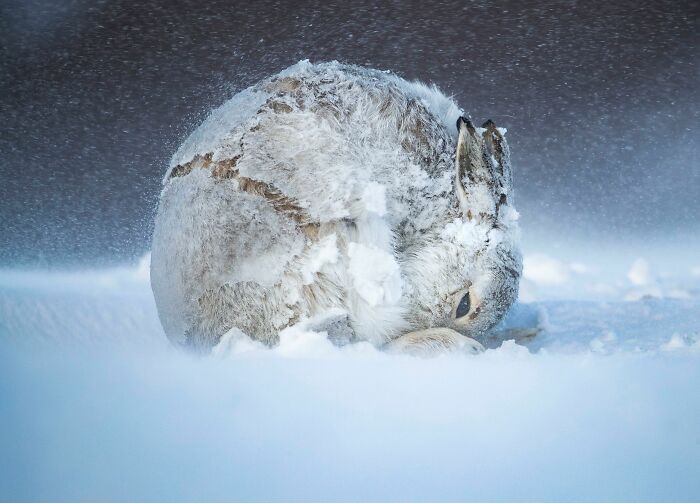
Image credits: nhm
#7 "Border Refuge" By Joseph Dominic Anthony
Joseph formed the idea for this photograph in 2016 on a visit to Mai Po Nature Reserve in Hong Kong. Taken within the Frontier Closed Area on the Chinese border, strictly timed access rules meant years of studying tide tables and waiting for the perfect weather. Joseph wanted to convey the story and mood of Mai Po in a single balanced photograph, combining individuals and the behaviour of multiple species in the context of their wider environment, particularly to juxtapose the proximity of the everencroaching urban development.
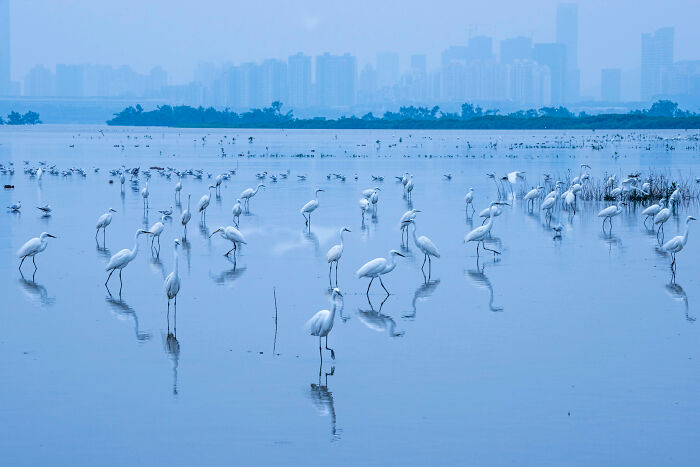
Image credits: nhm
#8 "Eye To Eye" By Andrey Shpatak
This Japanese warbonnet was photographed in the north of the Gulf of Oprichnik in the Sea of Japan. These unusual fish lead a territorial lifestyle among the stones and rocks of shallow coastal waters. They use their sharp-edged jaws to snap off sea cucumbers and gastropods. They were once thought to be timid and almost impossible to observe, but curiosity has taken over and they will now often swim right up to divers, who are usually startled by their extraordinary appearance
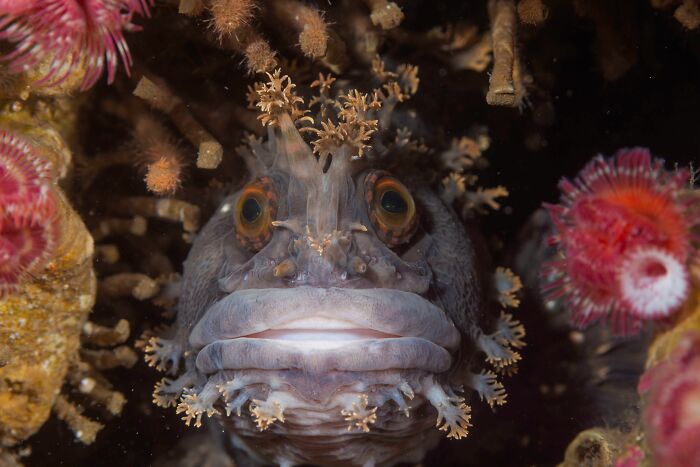
Image credits: nhm
#9 "Bat Woman" By Douglas Gimesy
Wildlife rescuer and carer Julie Malherbe takes a call to assist the next animal rescue while looking after three recently orphaned grey-headed flying-foxes. This megabat is native to Australia and is endemic to the southeastern forested areas, playing a vital role in seed dispersal and the pollination of more than 100 native species of flowering and fruit bearing trees. Sadly, the species is listed as vulnerable to extinction because of the destruction of foraging and roosting habitats and, more frequently, mass die-offs caused by heat-stress events.
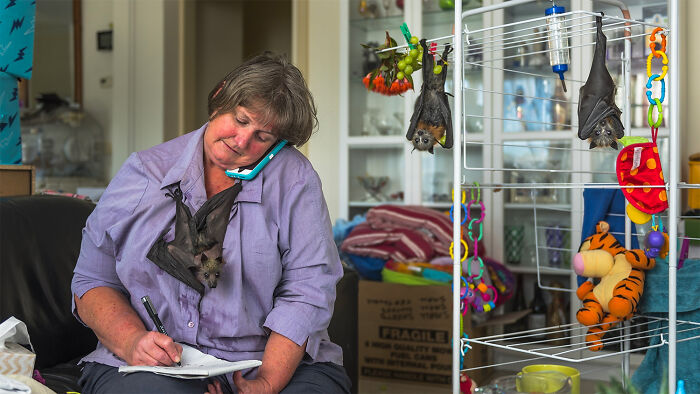
Image credits: nhm
#10 "Spirit Of Bhutan" By Emmanuel Rondeau
On assignment for WWF UK, Emmanuel’s brief was to photograph the elusive wildlife of the Bhutanese mountains. Surprised to find a rhododendron at an altitude of 3,500 metres (11,500 feet), he installed a camera trap, hoping, although not overly confident, that the large mammals he was there for would use the very narrow forest path nearby. Returning many weeks later, Emmanuel was amazed to find a head-on picture of a takin, with the colours of blue sky, pink flowers and mustardyellow coat of the beast perfectly complementing one another.
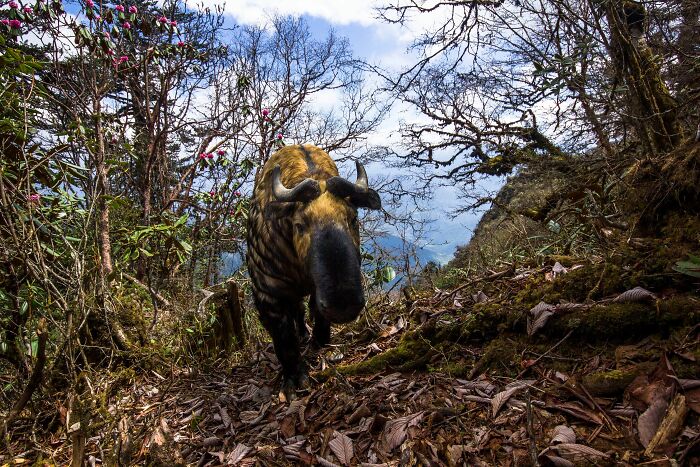
Image credits: nhm
#11 "A Window To Life" By Sergio Marijuán Campuzano
Two Iberian lynx kittens, Quijote and Queen, play in the abandoned hayloft where they were born. Extremely curious, but a bit scared as well, they started exploring the outside world through the windows of their straw-bale home. The reintroduction of the species to eastern Sierra Morena, Spain, has seen them, in more recent years, take advantage of some human environments. Their mother, Odrina, was also born in the hayloft, and her mother Mesta stayed with her for a whole year before leaving her daughter this safe and cosy place to raise her own family.

Image credits: nhm
#12 "Baby On The Rocks" By Frédéric Larrey
When this six-month-old snow leopard cub wasn’t following its mother and copying her movements, it sought protection among the rocks. This was the second family of snow leopards that Frédéric photographed on the Tibetan plateau in autumn 2017. Unlike other regions, where poaching is rife, there is a healthy breeding population in this mountain massif as the leopards are free from persecution by hunters and prey is plentiful.
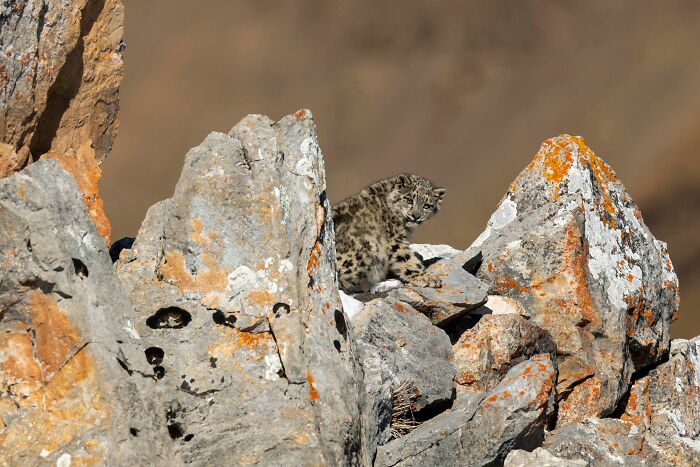
Image credits: nhm
#13 "Drey Dreaming" By Neil Anderson
As the weather grew colder, two Eurasian red squirrels (only one is clearly visible) found comfort and warmth in a box Neil had put up in one of the pine trees near his home in the Scottish Highlands. In the colder months, it’s common for the squirrels, even when unrelated, to share dreys. After discovering the box full of nesting material and in frequent use, Neil installed a camera and LED light with a diffuser on a dimmer. The box had a lot of natural light so he slowly increased the light to highlight his subjects – and using the WiFi app on his phone he was able take stills from the ground.
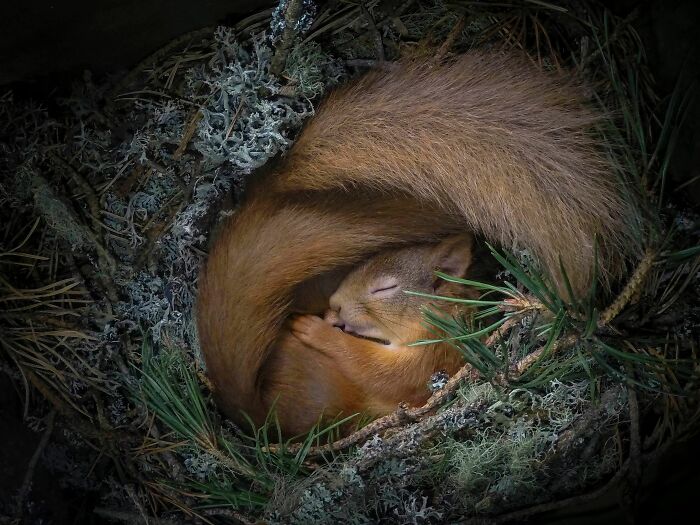
Image credits: nhm
#14 "A Special Moment" By Oliver Richter
Oliver has observed the European beavers near his home in Grimma, Saxony, Germany, for many years, watching as they redesign the landscape to create valuable habitats for many species of wildlife including kingfishers and dragonflies. This family portrait is at the beavers’ favourite feeding place and, for Oliver, the image reflects the care and love the adult beavers show towards their young.
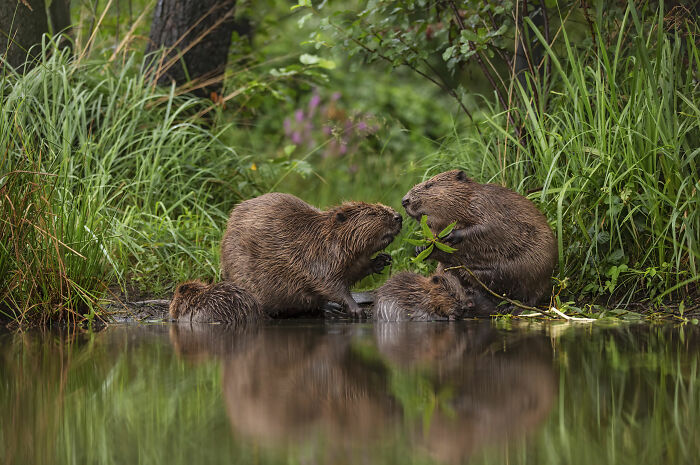
Image credits: nhm
#15 "The Alpha" By Mogens Trolle
Of all the different primate species Mogens has photographed, the mandrill has proved the most difficult to reach, preferring to hide in tropical forests in remote parts of Central Africa. This made the experience of sitting next to this impressive alpha, as he observed his troop above, even more special. When a male becomes alpha, he undergoes physical changes that accompany a rise in testosterone levels, and this results in the colours on his snout becoming much brighter. With the loss of status, the colours fade. Mogens used a flash to enhance the vivid colours and textures against the dark forest background.
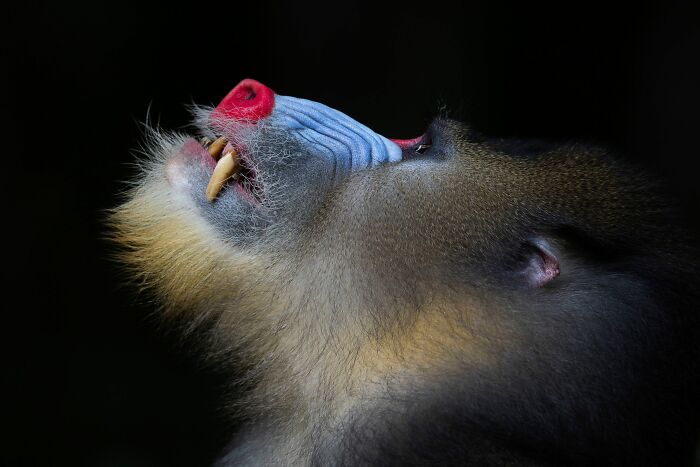
Image credits: nhm
#16 "Resting Dragon" By Gary Meredith
The Great Sandy Desert in Western Australia is home to a wide variety of wildlife, which exists alongside man-made mining operations. The wildlife found in this environment needs to adapt to the harsh, hostile living conditions. When the opportunity arises, the long-nosed dragon makes use of human structures. This individual positioned itself on a piece of wire mesh outside a workshop, waiting for the sun’s rays. The artificial light source outside the building attracts moths and insects, easy prey for a hungry lizard.
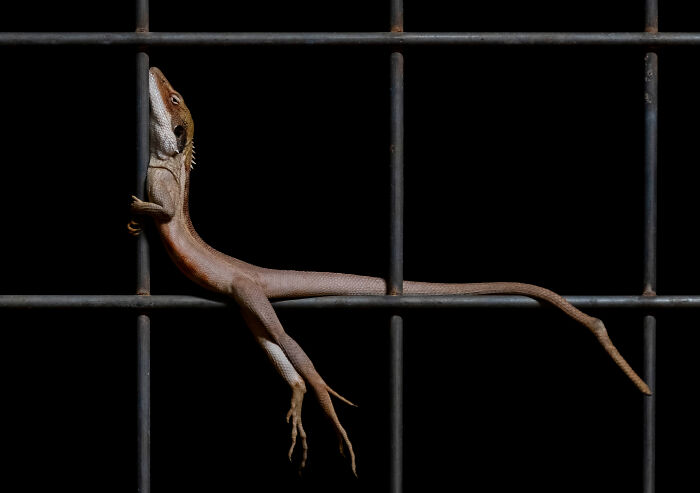
Image credits: nhm
#17 "Bushfire" By Robert Irwin
A fire line leaves a trail of destruction through woodland near the border of the Steve Irwin Wildlife Reserve in Cape York, Queensland, Australia. The area is of high conservation significance, with over 30 different ecosystems found there, and is home to many endangered species. The fires are one of the biggest threats to this precious habitat. Although natural fires or managed burns can be quite important in an ecosystem, when they are lit deliberately and without consideration, often to flush out feral pigs to hunt, they can rage out of control and have the potential to devastate huge areas.
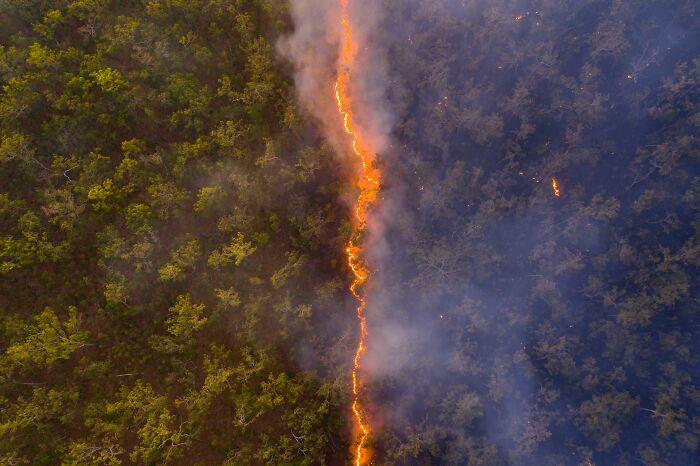
Image credits: nhm
#18 "Drawn And Quartered" By Laurent Ballesta
Scraps of grouper flesh fall from the jaws of two grey reef sharks as they tear the fish apart. The sharks of Fakarava Atoll, French Polynesia, hunt in packs, but do not share their prey. A single shark is too clumsy to catch even a drowsy grouper. After hunting together to roust the grouper from its hiding place in the reef, the sharks encircle it, but then compete for the spoils – only a few sharks will have a part of the catch and most of them will remain unfed for several nights.

Image credits: nhm
#19 "Coexistence" By Pallavi Prasad Laveti
A cheeky Asian palm civet kitten peeps from a bag in a small remote village in India, curiosity and playfulness shining in its eyes. This baby was orphaned and has lived its short life in the village backyard – comfortable in the company of locals, who have adopted the philosophy of ‘live and let live’. Pallavi sees the image as one of hope, for in other parts of the world the civets are trapped for Kopi Luwak coffee production (coffee made from coffee beans that are partially digested and then pooped out by the civet) – where they are contained in tiny, unsanitary battery cages and force fed a restricted diet of coffee beans. She feels this image portrays a true essence of cohabitation.
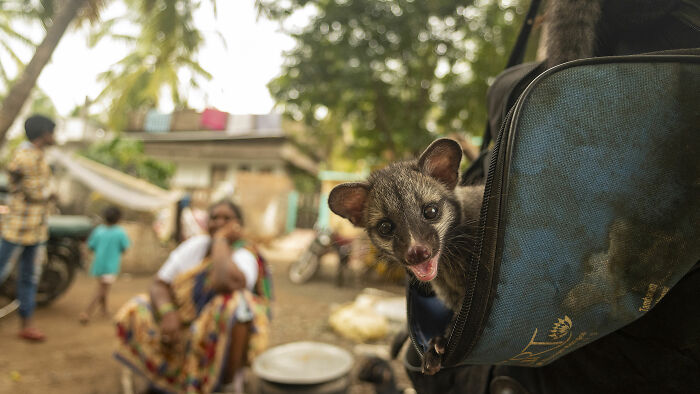
Image credits: nhm
#20 "Turtle Time Machine" By Thomas Peschak
During Christopher Columbus’s Caribbean voyage of 1494, green sea turtles were said to be so numerous that his ships almost ran aground on them. Today the species is classified as endangered. However, at locations like Little Farmer’s Cay in the Bahamas, green turtles can be observed with ease. An ecotourism project run by fishermen (some who used to hunt turtles) uses shellfish scraps to attract the turtles to the dock. Without a time machine it is impossible to see the pristine turtle population, but Thomas hopes that this image provides just a glimpse of the bounty our seas once held.
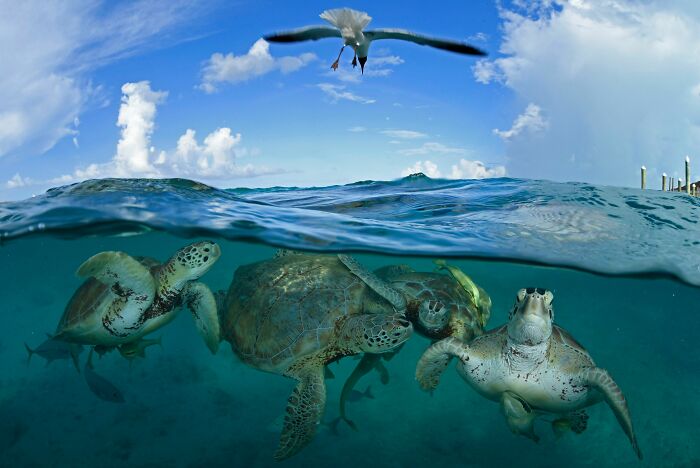
Image credits: nhm
#21 "Backstage At The Circus" By Kirsten Luce
At the Saint Petersburg State Circus, bear trainer Grant Ibragimov performs his daily act with three Siberian brown bears. The animals rehearse and then perform under the lights each evening. In order to train a bear to walk on two feet, Kirsten was told that they are chained by the neck to the wall when they are young to strengthen their leg muscles. Russia and Eastern Europe have a long history of training bears to dance or perform, and hundreds of bears continue to do so as part of the circus industry in this part of the world.
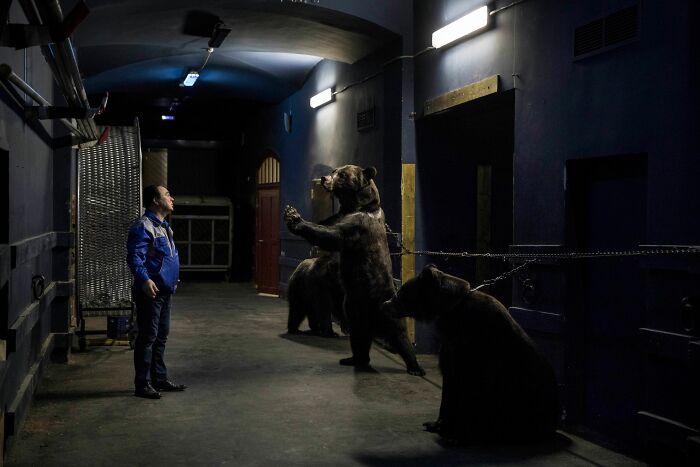
Image credits: nhm
#22 "White Danger" By Petri Pietiläinen
While on a photography trip to the Norwegian archipelago, Svalbard, Petri had hoped to spot polar bears. When one was sighted in the distance on a glacier, he switched from the main ship to a smaller rubber boat to get a closer look. The bear was making its way towards a steep cliff and the birds that were nesting there. It tried and failed several routes to reach them, but perseverance, and probably hunger, paid off as it found its way to a barnacle goose nest. Panic ensued as the adults and some of the chicks jumped off the cliff, leaving the bear to feed on what remained.
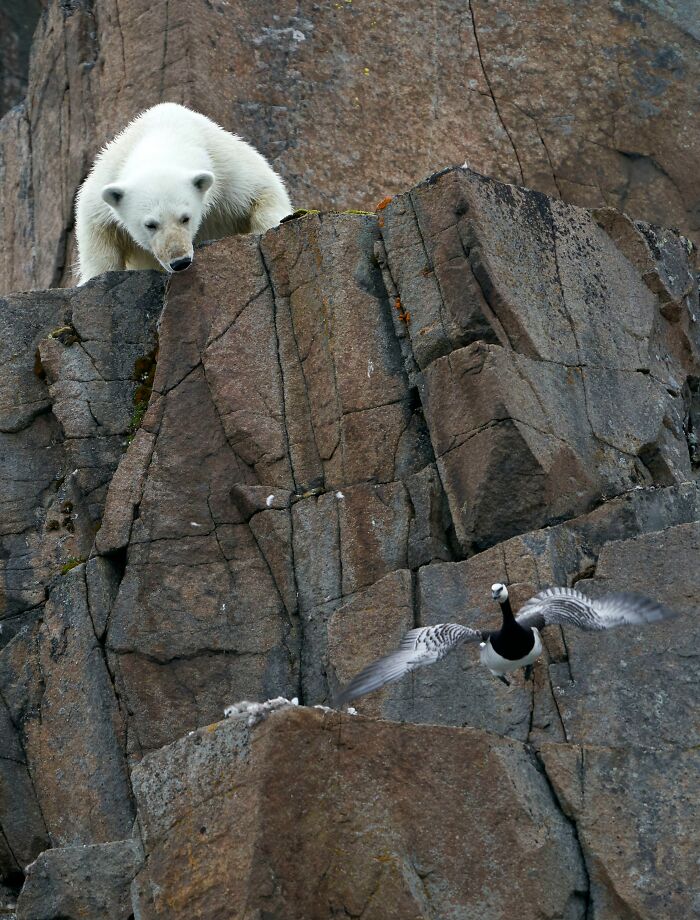
Image credits: nhm
#23 "The Real Garden Gnomes" By Karine Aigner
Located a short ride from the Florida Everglades, USA, Marco Island is the largest and only developed land in Florida's Ten Thousand Barrier Islands. This Gulf Coast retreat offers luxury resorts, beautiful beaches, multimillion-dollar neighbourhoods and, surprisingly, a thriving community of Florida burrowing owls. The owls dig their own burrows and are happy to take up residence on meticulously manicured lawns, the perfect place to hunt insects and lizards. The Marco Island owls are the new neighbours, and their human friends are (mostly!) thrilled to have them around.

Image credits: nhm
#24 "Life Saver" By Sergio Marijuán Campuzano
As urban areas grow, like Jaen in Spain, threats to wildlife increase, and Iberian lynx have become a casualty of traffic accidents as they too seek to expand their own territories. In 2019, over 34 lynx were run over, and three days before Sergio took this photo a two-year-old female lost her life not far from this spot. To combat mortality on the roads, improvements in the fencing and the construction of under-road tunnels are two proven solutions, and they are a lifeline for many other creatures as well as lynx.
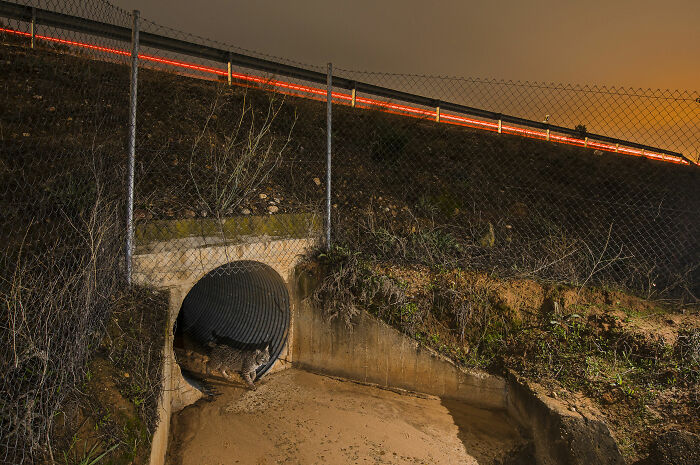
Image credits: nhm
#25 "Licence To Kill" By Britta Jaschinski
Britta’s photographs of items seized at airports and borders across the globe are a quest to understand why some individuals continue to demand wildlife products, even if this causes suffering and, in some cases, pushes species to the brink of extinction. This zebra head was confiscated at a border point in the USA. Most likely, the hunter was not able to show proof that the zebra was killed with a license. Britta found the use of a shopping trolley to move the confiscated item ironic, posing the question: wildlife or commodity?
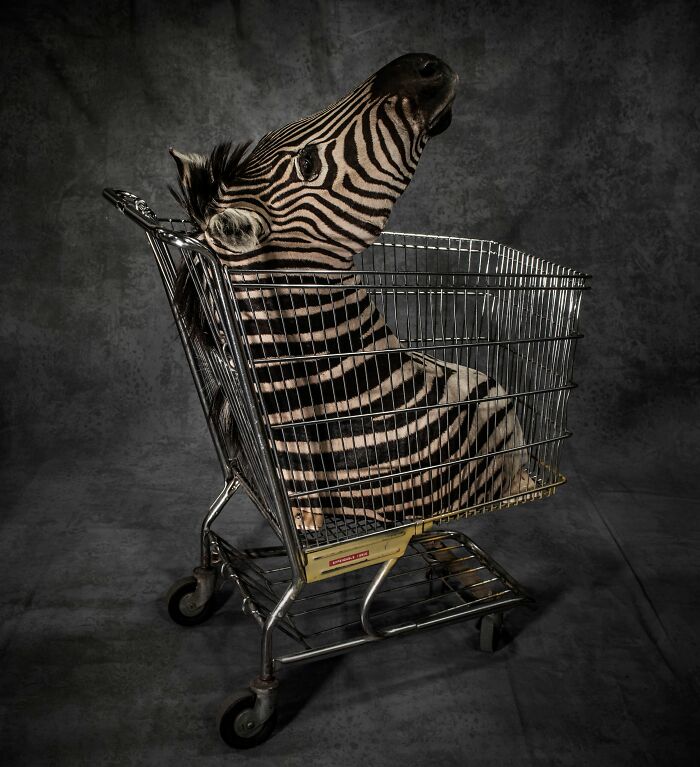
Image credits: nhm
from Bored Panda https://bit.ly/2XNLXlj
via Boredpanda